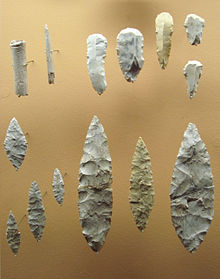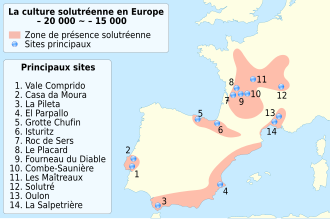Solutrean: Difference between revisions
→The Solutrean hypothesis in North American archaeology: unsourced / original research. |
Doug Weller (talk | contribs) Reverted to revision 569596965 by Goustien: Restore version before IP, which is not OR - sources can be found in the main article of which this is a short summary, move them here if you feel they are needed. (TW) |
||
| Line 21: | Line 21: | ||
[http://planet.uwc.ac.za/nisl/Conservation%20Biology/Karen%20PDF/Clovis/Bradley%20&%20Stanford%202004.pdf The North Atlantic ice-edge corridor: a possible Palaeolithic route to the New World]. Bruce Bradley and Dennis Stanford. World Archaeology 2004 Vol. 36(4): 459 – 478. |
[http://planet.uwc.ac.za/nisl/Conservation%20Biology/Karen%20PDF/Clovis/Bradley%20&%20Stanford%202004.pdf The North Atlantic ice-edge corridor: a possible Palaeolithic route to the New World]. Bruce Bradley and Dennis Stanford. World Archaeology 2004 Vol. 36(4): 459 – 478. |
||
</ref> This would mean that people would have had to move from the [[Bay of Biscay]] across the edge of the Atlantic ice sheet to [[North America]]. Supporters of this hypothesis believe it would have been feasible using traditional [[Eskimo]] techniques still in use today,<ref name=BBC /> while others argue that the conditions at the time would have made such a journey unlikely.<ref>Westley, Kieran; Justin Dix "[http://www.science.ulster.ac.uk/cma/Westley+Dix2008(Solutrean_Atlantic_Final).pdf The Solutrean Atlantic Hypothesis: A View from the Ocean]" ''Journal of the North Atlantic'' 2008 1:85–98</ref> |
</ref> This would mean that people would have had to move from the [[Bay of Biscay]] across the edge of the Atlantic ice sheet to [[North America]]. Supporters of this hypothesis believe it would have been feasible using traditional [[Eskimo]] techniques still in use today,<ref name=BBC /> while others argue that the conditions at the time would have made such a journey unlikely.<ref>Westley, Kieran; Justin Dix "[http://www.science.ulster.ac.uk/cma/Westley+Dix2008(Solutrean_Atlantic_Final).pdf The Solutrean Atlantic Hypothesis: A View from the Ocean]" ''Journal of the North Atlantic'' 2008 1:85–98</ref> |
||
The idea of a Clovis-Solutrean link remains controversial and does not enjoy wide acceptance. The hypothesis is challenged by large gaps in time between the Clovis and Solutrean eras, a lack of evidence of Solutrean seafaring, lack of specific Solutrean features in Clovis technology, and other issues. |
|||
==See also== |
==See also== |
||
Revision as of 21:24, 13 February 2014



The Solutrean industry is a relatively advanced flint tool-making style of the Upper Palaeolithic, from around 22,000 to 17,000 BP.
Details
"Solutrean" is named after the type-site of Crôt du Charnier at Solutré in the Mâcon district, Saône-et-Loire, eastern France, and appeared around 21,000 BP. The Solutré site was discovered in 1866 by the French geologist and paleontologist Henry Testot-Ferry (second son of Napoleon's famous cavalryman, General Claude Testot-Ferry, Baron of the Empire). It is now preserved as the Parc archéologique et botanique de Solutré.
The industry was named by Gabriel de Mortillet to describe the second stage of his system of cave chronology, following the Mousterian, and he considered it synchronous with the third division of the Quaternary period. The era's finds include tools, ornamental beads, and bone pins as well as prehistoric art.
Solutrean tool-making employed techniques not seen before and not rediscovered for millennia. The Solutrean has relatively finely worked, bifacial points made with lithic reduction percussion and pressure flaking rather than cruder flintknapping. Knapping was done using antler batons, hardwood batons and soft stone hammers. This method permitted the working of delicate slivers of flint to make light projectiles and even elaborate barbed and tanged arrowheads. Large thin spear-heads; scrapers with edge not on the side but on the end; flint knives and saws, but all still chipped, not ground or polished; long spear-points, with tang and shoulder on one side only, are also characteristic implements of this industry. Bone and antler were used as well.
The Solutrean may be seen as a transitory stage between the flint implements of the Mousterian and the bone implements of the Magdalenian epochs. Faunal finds include horse, reindeer, mammoth, cave lion, rhinoceros, bear and aurochs. Solutrean finds have been also made in the caves of Les Eyzies and Laugerie Haute, and in the Lower Beds of Creswell Crags in Derbyshire, England. The industry first appeared in what is now Spain, and disappears from the archaeological record around 17,000 BP.
The Solutrean hypothesis in North American archaeology
The Solutrean hypothesis builds on similarities between the Solutrean industry and the later Clovis culture / Clovis points of North America, and suggests that people with Solutrean tool-technology crossed the Ice Age Atlantic by moving along the pack ice edge, using survival skills similar to those of modern Eskimo people. The migrants arrived in northeastern North America and served as the donor culture for what eventually developed into Clovis tool-making technology. Archaeologists Dennis Stanford and Bruce Bradley suggest that the Clovis point derived from the points of the Solutrean culture of southern France (19,000 BP) through the Cactus Hill points of Virginia (16,000 BP) to the Clovis point.[1][2] This would mean that people would have had to move from the Bay of Biscay across the edge of the Atlantic ice sheet to North America. Supporters of this hypothesis believe it would have been feasible using traditional Eskimo techniques still in use today,[1] while others argue that the conditions at the time would have made such a journey unlikely.[3]
The idea of a Clovis-Solutrean link remains controversial and does not enjoy wide acceptance. The hypothesis is challenged by large gaps in time between the Clovis and Solutrean eras, a lack of evidence of Solutrean seafaring, lack of specific Solutrean features in Clovis technology, and other issues.
See also
| The Paleolithic |
|---|
| ↑ Pliocene (before Homo) |
| ↓ Mesolithic |
References
- This article incorporates text from a publication now in the public domain: Chisholm, Hugh, ed. (1911). Encyclopædia Britannica (11th ed.). Cambridge University Press.
{{cite encyclopedia}}: Missing or empty|title=(help)
- ^ a b "Stone Age Columbus – programme summary". BBC. March 2004. Retrieved 2010-12-10.
- ^ The North Atlantic ice-edge corridor: a possible Palaeolithic route to the New World. Bruce Bradley and Dennis Stanford. World Archaeology 2004 Vol. 36(4): 459 – 478.
- ^ Westley, Kieran; Justin Dix "The Solutrean Atlantic Hypothesis: A View from the Ocean" Journal of the North Atlantic 2008 1:85–98
External links
- Clovis and Solutrean: Is There a Common Thread? by James M. Chandler
- Stone Age Columbus BBC TV programme summary
- "America's Stone Age Explorers" transcript of 2004 NOVA program on PBS
- Images of Solutrean artifacts
- Radical theory of first Americans places Stone Age Europeans in Delmarva 20,000 years ago Washington Post article from 28 February 2012
- Picture gallery of the Paleolithic (reconstructional palaeoethnology), Libor Balák at the Czech Academy of Sciences, the Institute of Archaeology in Brno, The Center for Paleolithic and Paleoethnological Research
